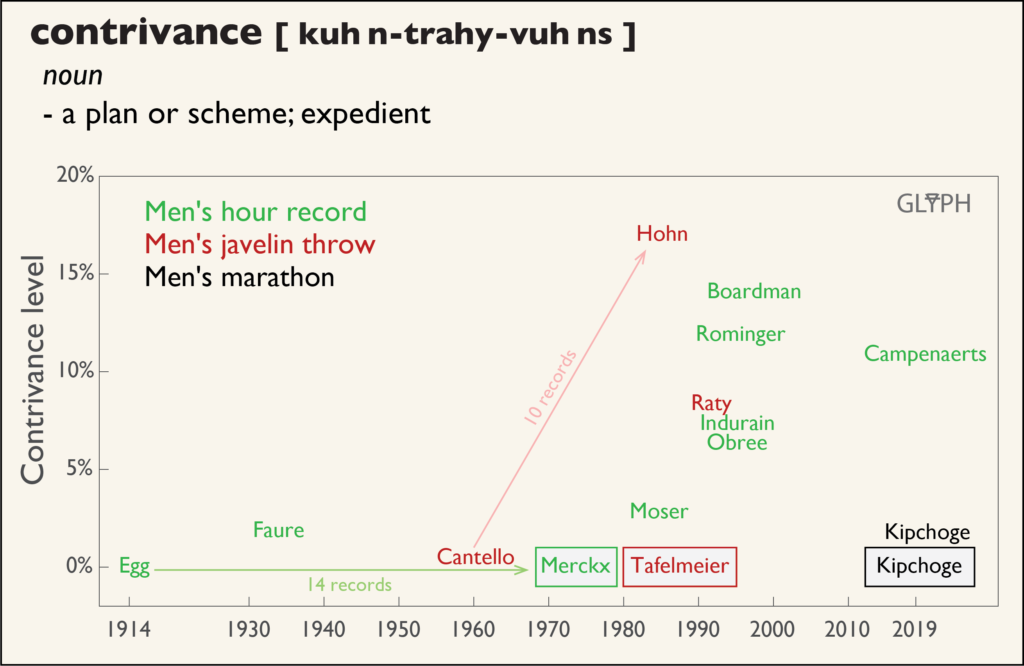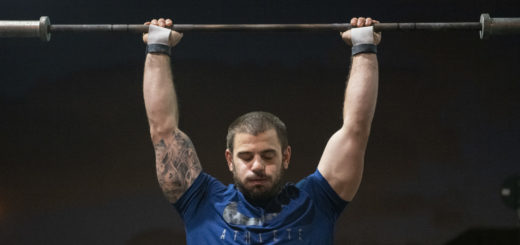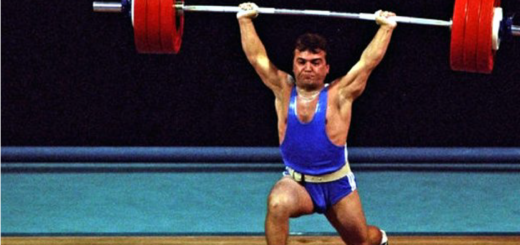A brief history of contrived records, Part 1
“And even if they say it’s not a world record, I have broken a barrier. Which makes a difference in human life, in a human family. That’s my evidence.”
Eliud Kipchoge

On October 12, 2019, Eliud Kipchoge ran 26.2 miles in less than 2 hours. For a variety of reasons including openly competitive laser rabbits (or something), he did not set a “marathon world record”, breaking that of…Eliud Kipchoge, set in Berlin in 2018. This won’t break any ground1 but a quick rundown of events is warranted.
Kipchoge has lost one marathon, and that guy had to break the world record to do it. His competition at the moment is history, so in May 2017, Nike organized an event to break 2 hours at the marathon distance. He missed by 26 seconds, so Ineos let him try again in October 2019 and he ran it in 1:59:40. Some of the features of the challenge were favorable but plausible features of a race: he had pacemakers running in formation to provide a draft, the course was flat and wind-free, and the time of year was chosen to yield a good chance at cool and dry conditions.
Unlike a normal race, the pacemakers (or rabbits) rotated in and out, there was a laser dot pointed ahead of the runners indicating the ideal pace, hydration was provided by bicycle, and it was not an open competition. For these reasons, the event set the record for the “fastest marathon distance”, certified by the people at Guinness rather than the IAAF. You would never claim that Kipchoge cheated to break the record here, because everyone involved entered into the proceedings knowing it was more of a testament to the limits of human ability rather than a sporting event.
It would be more accurate to state that the event was contrived. Probably the most extravagant contrivance in sporting history was that of Alan Shepard’s golf drive on the moon, which went somewhere between 200 yards and “miles and miles“. Given that he was hitting a 6-iron head screwed to an excavation tool one handed, even the former is fairly impressive. There’s a rich tapestry of such contrivances in sporting history, most of which are closer in spirit to the record being challenged. Three are shown in the image–Kipchoge v. Kipchoge in the marathon, the men’s hour record, and the men’s javelin.

Against the clock
One such series of events were the repeated assaults on the bicycle hour record made in the the mid-1990’s. The bicycle hour record is a slightly unusual time trial, in that instead of riding a fixed distance in the shortest possible time, the rider has one hour to ride as far as possible. It’s considered prestigious for a few reasons. First, it’s old—there has been an hour record pretty much from the coining of the term bicycle. Second, it’s one of the few easily describable objective records in cycling which is of appropriate duration to be set by a road rider; while we keep track of (for example) the fastest ascent of Mont Ventoux2, if you’re not familiar with that climb, it may not capture you. On the other hand, “one hour on a track with noone around you” needs no context to understand. Finally, and related intimately with the above points, some of cycling’s greatest names have held the record over the years. You can’t actually race Eddy Merckx in his prime, but you can ride the hour. Fausto Coppi, same. Jacques Anquetil, same.
Because it is a time-trial, aerodynamics are key to breaking the hour record. This was known early on; Oscar Egg’s 1914 mark of 44.247 km stood for almost 20 years until Francois Faure, sponsored by the manufacturer, got onto a “Velocar”—basically a recumbent—and beat it by 0.81 km. Cycling’s governing body, the Union Cycliste Internationale (UCI) called shenanigans pretty much immediately and made a bunch of rules that banned the more aerodynamic position. This was a couple of years before bike luddite, Tour de France founder, and (incidentally) hour record holder Henri Desgrange stepped away from the sport. A number of technologies were legalized in cycling’s premier race after his retirement3 so there’s an interesting counterfactual here—if Faure had waited a little longer, would recumbents have been just another technology like derailleurs and metal wheels that allowed riders to go a little faster?
Technological changes did settle down a little bit after the rush in the late 1930’s, and the bike that Eddy Merckx used to ride 49.431 km in 1972 would have been recognizable to a rider of that period. The next major change in cycling aerodynamics came out of the ultra-endurance world. Riders in the Race Across America (RAAM) built armrest aerobars to reduce energy expenditure during that event4. These were popularized in triathlons, and in 1989 Greg Lemond used Scott “tri-bars” to take 58 seconds from Laurent Fignon in the final stage of the Tour de France. At that point, it was a foregone conclusion that someone would break the hour record in a legal but “non-traditional” position.
Graeme Obree5 began the proceedings in 1993 in his own hands-to-chest “tuck” position. Chris Boardman broke it on tri-bars 6 days later, Obree took it back in 1994, road stars Miguel Indurain and Tony Rominger got into the mix, people started building monocoque frames out of carbon fiber and it all culminated in Boardman’s 56.375 km ride in September of 1996. The image only shows the fastest time achieved by each rider, because the pace of record-breaking was cluttering the graph.
At that point, the UCI had had enough of the arms race and made everyone break the record on a penny farthing, wearing a straw boater hat and a handlebar mustache. Poor Francesco Moser, who broke Merckx’s now-baseline 1972 record in 1984 using (horrors!) disk wheels, lost his record in the crossfire. However! In 2014, the UCI realized that no credible time trialist was ever training on anything resembling Merckx’s 1972 ride, and unified the bike limitations for the hour record to conform with those of the individual pursuit6. The present unified record, set in April of 2019 by Victor Campenaerts, represents a 10.8% “contrivance” relative to Merckx.
Against the tape
A slightly different type of technical change reset the rule book in the men’s javelin throw. By the early 1980’s, two things were happening. First, the best men’s competitors were on the verge of throwing the thing out of the infield, peaking with Uwe Hohn’s ”eternal world record” of 104.8 m in 1984. Second, the landing of the javelin was becoming increasingly flat, rather than sticking into the ground. This is a pain in the ass to judge, because it’s hard to mark the exact landing location of a flying javelin while being careful to avoid said erratically bouncing javelin.
The long throws and weird landings were intimately related. The javelin that Hohn was using could be thrown in such a way that the implement created lift throughout almost its entire flight. In 1986, the IAAF revised the rules constraining javelin construction, moving the center of mass forward, and increasing the minimum diameter of the tail. To understand why these changes would fix the problem, we have to have a brief math-free discussion about aerodynamic stability.
At some point, you may have been told that an arrow flies tip-first because the feathers make it stable, which is basically correct. In the context of an arrow, stability means that small disturbances to the arrow’s flight shrink rather than grow. The feathers promote this behavior because they are behind the arrow’s center of mass; if the angle of the arrow changes so that the arrow’s centerline is not aligned with its direction of flight, the arrows act like little wings and push the back of the arrow until it is flying straight again. A slightly more correct statement is therefore that an arrow is stable when its angle of attack is zero relative to the direction of air as seen by an observer on the arrow.
The subtlety is that slender objects (like arrows or javelins) can be designed so that they are stable about angles of attack other than zero. If that angle of attack is positive, the object will produce lift and fly farther. For an arcing javelin, this positive angle between the direction of its flight and the orientation of the javelin has the additional effect of making it do a belly-flop. If you want more details, R.M. Bartlett wrote an excellent discussion of the topic7 soon after the 1986 rules change.
The analysis considers Klaus Tafelmeier’s 1986 throw of 85.74 m with the new implement to be the baseline record for previous throws. What is notable is that you have to go back to 1956—twelve record holders—to find a world record throw which is less than Tafelmeier’s record. This means that whether it was elucidated or not, throwers had arrived at a technique to use the lift characteristics of the javelin to their advantage at least 28 years prior to Hohn’s eternal record. In some sense, you could consider Tafelmeier’s record to have been contrived, because the technique with the previous implement was so long-standing. Moving onto our final sport…
…oh, hey there, Seppo Raty! What’s your name doing there five goddamn years after the 1986 rules change? Because tweaking the javelin’s aerodynamics is so useful to making it fly farther, designers obviously had to tweak other still-legal features of the implement. Raty’s record was set using a so-called “rough-tail” javelin8 which was banned shortly after his mark. Popular sources sometimes claim that these rough tailed javelins increased the tail drag, which is not consistent with first-order (“Drag is bad”) or second-order (“Tail drag promotes zero-lift stable flight”) explanations of increasing flight distance. A contemporary academic investigation9 is more likely to be correct; carefully placed surface roughness near the grip could reduce flow separation behind the grip, reducing tail drag and moving the center of pressure closer to the center of mass.
There’s one more sport to go, but there were far, far too many data points to fit on the image. This last one has it all, though. Contrivances all the way down, war heros, iconic television sequences, the whole 277 yards. Should be up in a week.
- https://www.washingtonpost.com/sports/2019/10/15/lasers-rabbits-new-kicks-how-hour-marathon-barrier-was-broken/
- Iban Mayo, 2004 Dauphine Libere
- http://www.glyphstory.com/2019/07/08/le-tour-de-france-speed-spiral/
- https://www.triathlete.com/2010/07/insidetri/was-the-first-aerobar-really-not-the-first_11039
- Obree is our kind of weirdo, and this article cannot possibly do him justice. You owe it to yourself to at least peruse his wikipedia page. Highlights include: building your own bike out of washing machine parts, showing up to your first race in wildly unsuitable clothing, and (most relevant to this discussion) inventing two different riding positions which were banned by the UCI.
- https://www.velonews.com/2014/05/bikes-and-tech/uci-changes-hour-record-regulations-allows-modern-track-bikes_328018
- Bartlett, R. M. “The aerodynamics of javelin flight-a re-evaluation.” ISBS-Conference Proceedings Archive. 1987.
- or Nemeth javelin, after Olympic champion turned inventor and practical aerodynamicist Miklos Nemeth. It goes without saying that it is the fondest dream of this website to have a banned piece of sporting equipment or technique named after it.
- Best, Russell J., Roger M. Bartlett, and Richard A. Sawyer. “Optimal javelin release.” Journal of Applied Biomechanics 11.4 (1995): 371-394.




1 Response
[…] from coasting up part of your descent. Your authors are not reasonable, and consider the use of spacecraft and earth moving equipment to be fair game in the pursuit of sporting glory. Before we make this […]